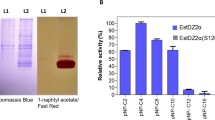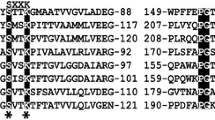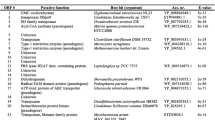Abstract
The realization that majority of microbes are not amenable to cultivation as isolates under laboratory conditions has led to the culture-independent metagenomic approach as a novel technique for novel biocatalyst discovery. A leachate fosmid shotgun metagenome library was constructed and subsequently screened for esterolytic activities on a tributyrin agar medium. Nucleotide sequencing and translational analysis of an esterase-positive fosmid clone led to the identification of a 1,281 bp esterase gene (estC) encoding a protein (EstC) of 427 aa with translated molecular weight of 46.3 kDa. The EstC primary structure contained a signal leader peptide (29 aa), which could be cleaved to form a mature protein of 398 aa with molecular weight 43.3 kDa. Homology searches revealed that EstC belonged to the family VIII esterases, which exploit a serine residue within the S-x-x-K motif as a catalytic nucleophile. Substrate specificity studies showed that EstC prefers short to medium acyl chain length of p-nitrophenyl esters, a characteristic typical of “true” carboxylesterases. Moreover, EstC represents the first member of the family VIII esterases with a leader peptide and a detectable promiscuous β-lactam hydrolytic activity. Site-directed mutagenesis studies also revealed that in addition to Ser103 and Lys106 residues, the Tyr219 residue also plays a catalytic role in EstC. The organic solvent stability and the specificity towards esters of tertiary alcohols linalyl acetate (3,7-dimethyl-1,6-octadien-3-yl acetate) make EstC potentially useful in biocatalysis.



Similar content being viewed by others

References
Altschul SF, Madden TS, Schäffer AA, Zhang J, Zhang Z, Miller W, Lipman DJ (1997) Gapped BLAST and PSI-BLAST: a new generation of protein database search programs. Nucl Acids Res 25:3389–3402
Arpigny KL, Jaeger KE (1999) Bacterial lipolytic enzymes: classification and properties. J Biochem 343:177–183
Avison BM, Niumsup P, Walsh TR, Bennett PM (2000) Aeromonas hydrophila AmpH and CepH ß-lactamases: depressed expression in mutants of Escherichia coli lacking creB. J Antimicro A Chemother 46:695–702
Bendten JD, Nielsen H, von Heijnie G, Brunak S (2004) Improved prediction of signal peptide: SignalP 3.0. J Mol Biol 340:783–795
Berger R, Hoffmann M, Keller U (1998) Molecular analysis of a gene encoding a cell bound esterase from Streptomyces chrysomallus. J Bacteriol 180:6396–6399
Bornscheuer UT (2002) Microbial carboxylesterases: classification, properties and application in biocatalysis. FEMS Microbiol Rev 26:73–81
Bradford MM (1976) A rapid and sensitive method for quantification of microgram quantities of protein utilizing the principle of protein-dye binding. J Anal Biochem 72:248–254
Cowan D, Meyer Q, Stafford W, Muyanga S, Cameron R, Wittwer P (2005) Metagenomic gene discovery: past, present and future. Trends Biotech 23:321–329
Elend C, Scheisser C, Leggewie C, Babiak P, Carballeira D, Steele L, Reymond L, Jaeger K, Streit W (2006) Isolation and biochemical characterization of two novel metagenome-derived esterases. Appl Environ Microbiol 72:3637–2645
Gabor EM, Alkema WB, Janssen DB (2004) Quantifying the accessibility of the metagenome by random expression cloning technique. Environ Microbiol 6:948–958
Gans J, Wolinsky M, Dunbar J (2005) Computational improvements reveal great bacterial diversity and high metal toxicity in soil. Science 309:1387–1390
Gilliespie DE, Brady SF, Bettermann AD, Cianciotto NP, Liles MR, Rondon MR, Goodman RM, Handelsman J (2002) Isolation of antibiotics turbomycinA and B from metagenomic library of soil microbial DNA. Appl Environ Microbiol 68:4301–4306
Gilliespie DE, Rondon MR, Goodman RM, Handelsman J, Williamson LL (2005) Metagenomic library from uncultured microorganisms. In: Osborn AM, Smith CJ (eds) Molecular microbial ecology. Taylor and Francis group, New York, pp 261–279 Ch1
Hall TA (1990) BioEdit: a user friendly biological sequence alignment editor and analysis program for Windows 95/98/NT. Nucl acids Symp Ser 41:95–98
Henke E, Pleiss J, Bornscheuer UT (2002) Activity of lipases and esterases towards tertiary alcohols: insights into structure-function relationships. Angew Chem Int Ed 41:3211–3213
Jaeger KE, Dijkstra BW, Reetz MT (1999) Bacterial biocatalysis: molecular biology, three-dimensional structures, and biotechnological applications of lipases. Ann Rev Microbiol 53:315–351
Joris B, Ghuysens JM, Dive G, Renard A, Dideberg O, Charlier P, Frere JM, Kelly JA, Boyington JC, Moews PC (1988) The active-site-serine penicillin-recognizing enzymes as members of the Streptomyces R61 DD-peptidase family. J Biochem 250:313–324
Knox JR, Moews PC, Frere JM (1996) Molecular evolution of bacterial β-lactam resistance. Chem Bio 3:937–947
Kouker G, Jaeger KE (1987) Specific and sensitive plate assay for bacterial lipases. Appl Environ Microbiol 53:211–213
Kourist R, Bartsch S, Fransson L, Hult K, Bornscheuer U (2008a) Understanding promiscuous amidase activity of an esterase from Bacillus subtilis. Chem BioChem 9:67–69
Kourist R, de Maria P, Bornscheuer U (2008b) Enzyme synthesis of optically active tertiary alcohols: expanding the bioclaysis toolbox. Chem BioChem 9:491–498
Laemmli UK (1970) Cleavage of structural proteins during the assembly of the head of bacteriophage T4. Nature 227:680–685
Lammle K, Zipper H, Breuer M, Hauer B, Buta C, Brunner H, Rupp S (2007) Identification of novel enzymes with different hydrolytic activities by metagenome expression cloning. J Biotechnol 127:575–592
Lorenz P, Liebeton K, Niehaus F, Eck K (2002) Screening novel enzymes for biocatalytic processes: accessing the metagenome as a resource of novel functional sequences space. Curr Opin Biotechnol 13:572–577
Nishizawa M, Shimizu M, Ohkawa H, Kanaoka M (1995) Stereoselective production of (+)-trans-chrysantemic acid by microbial esterase: cloning, nucleotide sequence, and overexpression of the esterase gene of Arthrobacter globiformis in Escherichia coli. Appl Environ Microbiol 61:3208–3215
Oefner C, D’Arcy A, Daly JJ, Gubernator K, Charnas RL, Heinze I, Hubschwerlen C, Winkler FK (1990) Refined crystal structure of beta-lactamase from Citrobacter freundii indicates a mechanism for beta-lactam hydrolysis. Nature 343:284–288
Ogino H, Mimitsuka T, Muto T, Matsumura M, Yasuda M, Ishimi K, Ishikawa H (2004) Cloning, expression, and characterization of a lipolytic enzyme gene (lip8) from Pseudomonas aeruginosa LST-03. J Mol Microbiol Biotechnol 7:212–223
Petersen EI, Valinger G, Solkner B, Stubenrauch G, Schwab H (2001) A novel esterase from Burkholderia gladioli shows high deacetylation activity on cephalosporins is related to β-lactamases and DD-peptidases. J Biotechnol 89:11–25
Rashamuse K, Ronneburg F, Hennessy F, Visser D, van Heerden E, Piater L, Litthauer D, Moller C, Brady D (2009) Discovery of a novel carboxylesterase through functional screening of pre-enriched environmental library. J Appl Microbiol. doi:https://doi.org/10.1111/j.1365-2672.2008.04114.x
Rashamuse K, Burton S, Stafford W, Cowan D (2007a) Molecular characterization of a novel family VIII esterase from Burkholderia multivorans UWC10. J Mol Microbiol Biotechnol 13:181–188
Rashamuse K, Burton S, Cowan D (2007b) A novel recombinant ethyl ferulate esterase from Burkholderia multivorans. J Appl Microbiol 103:1610–1620
Rondon MR, August PR, Bettermann AD, Brady SF, Grossman TH, Liles MR, Loiacone KA, Lynch BA, MacNeil IA, Minor C (2000) Cloning the soil metagenome: a strategy for accessing the genetic and functional diversity of uncultured microorganisms. Appl Environ Microbiol 66:2541–2547
Sakai Y, Ishikawa J, Fukasaka S, Yumiroto H, Mitsui R, Yanaese H, Kato N (1999) A new carboxylesterase from Brevibacterium lines IFO 12171 responsible for the conversion of 1,4-butanediol diacrylate to 4-hydroxybutyl acrylate: purification, characterization, gene cloning and gene expression in Escherichia coli. Biosci Biotechnol Biochem 63:688–697
Sambrook J, Russell DW (2001) Molecular cloning: a laboratory manual, 3rd edn. Cold Spring Harbor Laboratory, Cold Spring Harbor
Schutte M, Fetzner S (2007) EstA from Arthrobacter nitroguajacolicus R_61a, a thermo- and solvent-tolerant carboxylesterase related to class C β-lactamases. Curr Microbiol 54:230–236
Wagner GU, Petersen EI, Schwab H, Kratky C (2002) EstB from Burkholderia gladioli: A novel esterase with a β-lactamase fold reveals steric factors discriminate between esterolytic and β-lactam cleaving activity. Protein Sci 11:467–478
Wahler D, Reymond JL (2001) Novel methods for biocatalyst screening. Curr Opin Chem Biol 5:152–158
Zawadzke LE, Chen CCH, Banjeree S, Li Z, Wasch S, Kapadia G, Moult J, Herzberg O (1996) Elimination of the hydrolytic water molecule in a class A β-lactamase mutant—crystal structure and kinetics. J Biochem 35:16475–16482
Acknowledgments
The work was supported by the CSIR-YREF (Young Researcher Establishment Fund). The authors would also like to thank Mr Harris Tshwane Manchidi for the help with sample collection, Dr Edwin Mutlane for synthesizing the p-nitrobutyranilide substrate, and the members of the CSIR (Enzyme technologies group) for their useful comments and suggestions.
Author information
Authors and Affiliations
Corresponding author
Rights and permissions
About this article
Cite this article
Rashamuse, K., Magomani, V., Ronneburg, T. et al. A novel family VIII carboxylesterase derived from a leachate metagenome library exhibits promiscuous β-lactamase activity on nitrocefin. Appl Microbiol Biotechnol 83, 491–500 (2009). https://doi.org/10.1007/s00253-009-1895-x
Received:
Revised:
Accepted:
Published:
Issue Date:
DOI: https://doi.org/10.1007/s00253-009-1895-x



